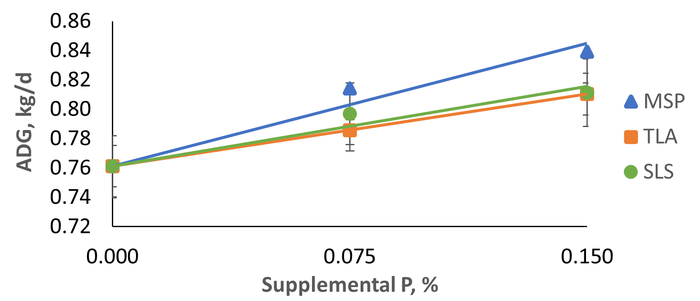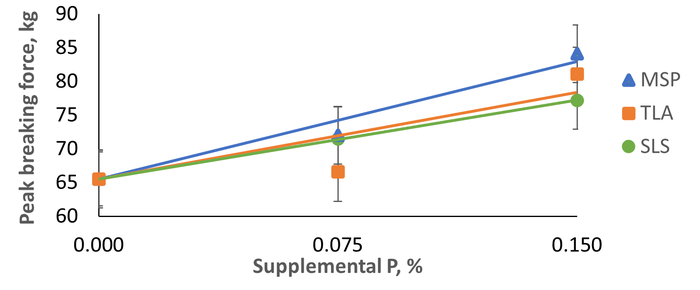Value of recycled phosphorus from swine waste in diet formulation
Data suggests bioavailability of phosphorus from turkey litter ash, dried swine lagoon sludge is approximately 60 to 70% relative to monosodium phosphate.
October 6, 2022

Mineral rich products derived from animal manure are often recycled through the use as fertilizer, primarily for its nitrogen and phosphorus contributions. Another potential avenue of utilizing nutrients from animal manure is through combustion for the generation of energy, leaving an inorganic, sterile ash product that has the potential of being recycled back into animal feed. Previous work conducted at North Carolina State University showed that ash from poultry litter, swine manure solids and swine mortalities could serve as a digestible phosphorus source in diets for swine.
We conducted a study to more closely evaluate the bioavailability of phosphorus in poultry litter ash and swine lagoon sludge. Swine lagoon sludge is the nutrient rich residue that settles in the bottom of anaerobic swine lagoons. It is rich in phosphorus, but also contains relatively high levels of zinc and copper.
For the study, we used 56 crossbred barrows, weighing an average of 77 pounds. They were housed individually and were limit-fed daily at three times their maintenance requirement. Feed was given twice daily at 8 a.m. and 4 p.m. and pigs had unlimited access to water. Dietary treatments consisted of a negative control diet that was deficient in phosphorus (40% of the suggested requirement from NRC, 2012) and negative control diets with additional phosphorus at 0.075%, or 0.150% from either monosodium phosphate, turkey litter ash or dried swine lagoon sludge.
Monosodium phosphate was chosen as a standard with a reported phosphorus availability value of 100%. The bioavailability of phosphorus in TLA and SLS could then be directly calculated and compared to this standard. The TLA used in this study was analyzed to contain 8.31% calcium, 3.98% phosphorus and 0.70% sodium, whereas SLS contained 5.81% calcium, 4.31% phosphorus and 0.12% sodium. These values were used in the formulation of the experimental diets. Thus, diets were balanced as appropriate for the experimental design, maintaining a constant calcium to phosphorus ratio of 1.4 to 1, and using builder sand as a filler to maintain equal inclusion of all other ingredients across diets.
Diets were fed for a total period of 28 days and pig growth rates were determined, as shown in Figure 1. Supplementation of phosphorus increased average daily gain for all phosphorus sources, but especially when phosphorus was supplied by MSP, as was expected. This indicates that phosphorus in TLA and SLS was less bioavailable than phosphorus from MSP. The slope for MSP in Figure 1 was 0.558 suggestion that for every extra unit of phosphorus, average daily gain increased by 0.558 kg per day. The slopes for TLA and SLS were 0.327 and 0.363, respectively. The ratio of the slopes relative to the slope obtained for MSP represents the relative bioavailability of phosphorus (assuming that the bioavailability of phosphorus in MSP is 100%). These data suggest a bioavailability of phosphorus of 58.6% for TLA and 65.1 for SLS.

We also collected 3rd metacarpal bones from all pigs at the end of the 28-day study. Bone length was measured with a digital caliper before being evaluated for bone strength using a three-point bending test with 5 cm between the supports and a 250 kg load cell. Peak breaking strength was defined as the maximum load supported before failure.
Bone strength is often considered the most sensitive parameter in the evaluation of calcium and phosphorus requirements. As can be seen in Figure 2, increasing supplemental phosphorus increased peak bone breaking strength for all phosphorus sources. The response was greater when phosphorus was supplemented from MSP as indicated by the greater slope of the line at 116.3, compared to a slope of 85.7 for TLA and 78.0 for SLS. Thus, the calculated relative bioavailability using peak bone breaking strength was 73.8% for TLA and 67.1% for SLS.

This study evaluated the bioavailability of phosphorus from turkey litter ash and dried swine lagoon sludge relative monosodium phosphate, which was used as a highly available phosphorus control. Data suggest that the bioavailability of phosphorus from turkey litter ash and dried swine lagoon sludge is approximately 60 to 70% relative to monosodium phosphate. Thus, these recycled waste products can serve as potential valuable alternative sources of phosphorus for swine.
Source: Cooper McAuley and Eric van Heugten, who are solely responsible for the information provided, and wholly owns the information. Informa Business Media and all its subsidiaries are not responsible for any of the content contained in this information asset.
You May Also Like



